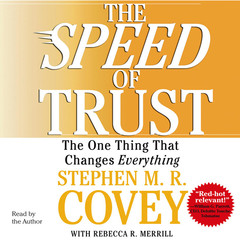Drawn from “Speed of Trust” by Stephen M.R. Covey The Collier Companies Fall 2013 Conference of Champions featured a two day “Speed of Trust” seminar by FranklinCovey
Clarifying expectations can be challenging. Words mean different things to different people:
“We do a small group exercise where people
list the top 10 words that come to mind as they answer the question,
What is trust?
Even though ‘trust’ is a word we use all the time,
people at each table will not come up with more than one or two words in common.”
– Sean Covey, “Speed of Trust”
“Speed of Trust” teaches to clarify expectations, Quantify Everything, focusing on results rather than activities and always bearing in mind the trade-off between quality, speed and cost:
“- What result?
– By whom?
– By when?
– At what cost?
– How will we measure it?
– How will we know when we have accomplished it?
– And when and to whom is the accountability— both in terms of benchmarks and end results?”
Because we know our own minds (or think we do!) it is easy to assume that others see the world as we do and can understand our vision and expectations, not realizing that often even to ourselves we may have blank areas or concepts that are vague or not fully thought out. Relying upon memories or differing individual interpretations (including beliefs as to what is possible) can lead to a hefty ‘trust tax’.
People see and approach the world differently and this can make both “Clarifying Expectations” and “Quantifying Everything” extremely difficult. For one thing, “Not everything that matters can be measured and not everything that can be measured matters.”
While everyone uses a mixture of both and may even have different approaches in different life roles, styles can often be categorized as left brain (logic) v. right brain (relationship oriented). For instance, think creative type v. engineer, soft v. hard, EQ (emotional quotient) v. IQ (intelligence quotient), seeing the world as black and white v. shades of grey or points on a continuum or on a distribution curve.
I find it both very important and exceedingly challenging to clarify expectations. As a bootstrap entrepreneur, I tend to see a complex world, full of infinite variables and endless trade-offs, where unforeseen opportunities frequently pop up begging to be harvested and unknowable complications inevitably arise. Furthermore, I am very much an experimental, visual person, so my expectations are often of the “I’ll know it when I see it” variety. Also, having built a business over 40+ years from a single house to 10,000 apartments, I am very much an “Iterative Thinker”—I try something and if works, I do more. If it doesn’t, I tweak it and try it again. Try putting that in a business plan!
Also, some goals are like baseball. You want to hit a home run every time but just getting on base is an achievement that can be built on. So is the goal a home run or 1st base? If I say it is both, am I being unclear?
Other situations are akin to “3 steps into the fog”. You know your ultimate goal is the far shore but you can only see 3 steps ahead. However, when you take a couple of steps forward you see the next few step more clearly. How do you clarify in that type of situation?
Often what needs to be done lies outside peoples’ comfort zone, beyond what they believe possible yet you as the leader believe it is possible and yet you also know there is an element of self-fulfilling prophecy – “Think you can, think you can’t, you are right.”
At the highest level, expectations can be the Ritz Carlton motto of “Ladies and Gentleman serving Ladies and Gentleman” but that begs the question of what is a lady and what is a gentleman much less what constitutes proper service.
One counterfeit of clarifying expectations is “Box Checking” where as long as you’ve checked off every box on the checklist, you are absolved of further responsibility. The Collier Companies is in the business of owning and managing apartment communities. We can and have created “checklists” literally hundreds of items long and they have value as training tools. At the same time, things frequently come up that are not specifically on the checklist yet still need to be done.
Another trap is putting too much faith in numbers or formulas with no “common sense” or “good faith/fairness” safeguard check on the ultimate outcome. From ridiculous shareholder rip-off CEO bonuses to tragic mandatory sentencing outcomes to silly Zero Tolerance policy results, relying solely on “the numbers” is an abdication of leadership responsibility.
In summary, clarify expectations is exceedingly important. It may not always be possible to achieve perfect clarity around a common vision but we can move the needle, we can get closer and that alone is generally well worth the effort.
Closing Quotes:
“High achievement always takes place in the framework of high expectation.” – Charles F. Kettering, 1876 – 1958, founder of Delco and holder of 186 patents
“Achievement is largely the product of steadily raising one’s levels of aspiration and expectation.” – Jack Nicklaus, b. 1940, golfer, winner of 18 majors
“We tend to live up (or down) to our expectations.”– Earl Nightingale, 1921- 1989, enlisted in US Marines at 17, on USS Arizona during the attack on Pearl Harbor (one of twelve surviving Marines)


